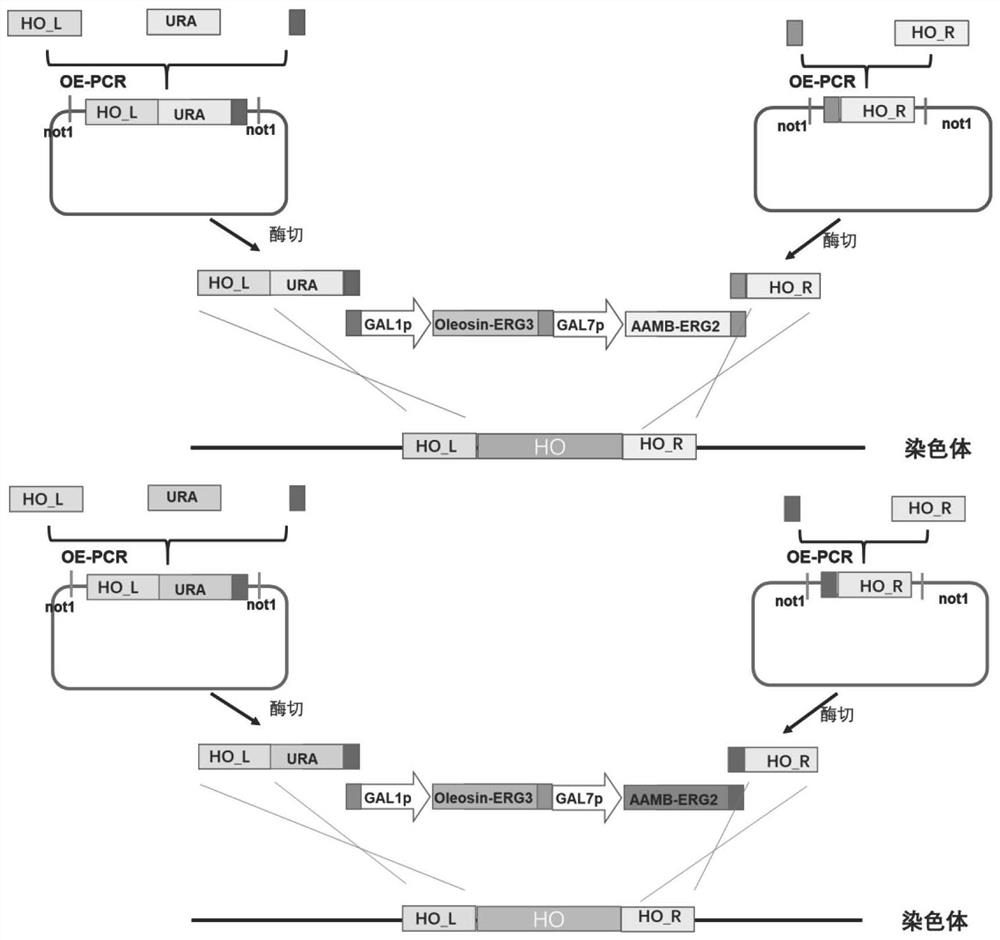Recombinant saccharomyces cerevisiaes for producing 7-dehydrocholesterol and construction method thereof
A technology of dehydrocholesterol and recombinant strains, applied in the field of microbial metabolism, to achieve the effect of increasing production
- Summary
- Abstract
- Description
- Claims
- Application Information
AI Technical Summary
Problems solved by technology
Method used
Image
Examples
Embodiment 1
[0081] Example 1 Rearrange the organelle distribution of enzymes downstream of yeast sterols to increase the yield of 7-dehydrocholesterol The preliminary construction method of the recombinant Saccharomyces cerevisiae strain producing 7-dehydrocholesterol of the present invention is as follows:
[0082] 1. The high-yielding 7-dehydrocholesterol Saccharomyces cerevisiae was provided by Yuan Yingjin's research group, and the strain number is SyBE_Sc0125X001 (Guo, X.J., Xiao, W.H., Wang, Y., Yao, M.D., Zeng, B.X., Liu, H. , Zhao, G.R., and Yuan, Y.J. (2018). Metabolic engineering of Saccharomyces cerevisiae for 7-dehydrocholesterol overproduction. Biotechnol Biofuels 11, 192).
[0083] 2. Acquisition of exogenous functional gene elements
[0084] The exogenous gene is the C24 reductase gene DHCR24 (as shown in SEQ ID No.1) used for the synthesis of 7-dehydrocholesterol, and the source is chicken source (gallus). After circumventing common restriction enzyme cutting sites, 5' en...
Embodiment 2
[0107] Example 2 Rearranging the organelle distribution of yeast sterol upstream enzymes to improve 7-dehydrocholesterol production
[0108] 1. Construction of modular integration plasmids
[0109] First, the applicant designed to divide the enzymes present in the endoplasmic reticulum upstream of zymosterol in the post-squalene pathway into two modules: ERG1-ERG11-ERG24 is the first module, and ERG25-ERG26-ERG27 is the second module. In order to ensure the stable existence of the module, a method of integrating the module into the genome is selected. Since repeated sequences in Saccharomyces cerevisiae are easy to produce repeated sequences and are lost from the genome by homologous recombination, it is necessary to avoid the integration of two modules containing AAM-B sequences at the same site, so this experiment is designed to The first two genes of the three genes in the module were fused, and the Oleosin sequence was placed between the two genes for positioning; the thi...
Embodiment 3
[0123] Example 3 Combining the organelle distribution of the upstream and downstream enzymes of zymosterol to further improve the production of 7-dehydrocholesterol
[0124] 1. Construction of modular integration plasmids
[0125] In order to further reduce the by-products in the strain, the authors introduced the downstream genes ERG2 and ERG3 in the post-squalene pathway into the tau3 site in the high-yield 7-dehydrocholesterol strain. The specific construction process is to use the genome as a template to amplify the 700bp fragment upstream and downstream of tau3 and the terminators TDH2t and PGK1t. The upstream homology arm tau3_L was obtained by linking tau3_up700 and TDH2t by OE-PCR, and the downstream homology arm tau3_R was obtained by linking PGK1t and tau3_down700.
[0126] 2. Modular integration construction of recombinant Saccharomyces cerevisiae strains producing 7-dehydrocholesterol
[0127] First, cut the previously constructed expression module TDH2t-gal1p-ER...
PUM
 Login to View More
Login to View More Abstract
Description
Claims
Application Information
 Login to View More
Login to View More - R&D
- Intellectual Property
- Life Sciences
- Materials
- Tech Scout
- Unparalleled Data Quality
- Higher Quality Content
- 60% Fewer Hallucinations
Browse by: Latest US Patents, China's latest patents, Technical Efficacy Thesaurus, Application Domain, Technology Topic, Popular Technical Reports.
© 2025 PatSnap. All rights reserved.Legal|Privacy policy|Modern Slavery Act Transparency Statement|Sitemap|About US| Contact US: help@patsnap.com



